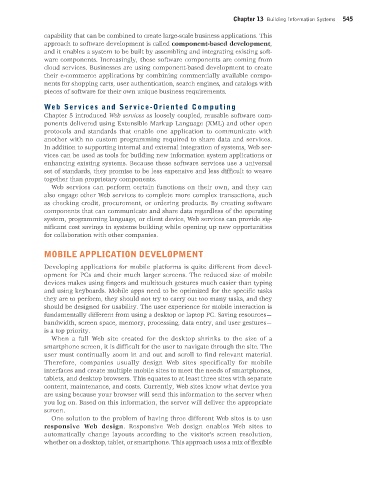Page 546 -
P. 546
Chapter 13 Building Information Systems 545
capability that can be combined to create large-scale business applications. This
approach to software development is called component-based development,
and it enables a system to be built by assembling and integrating existing soft-
ware components. Increasingly, these software components are coming from
cloud services. Businesses are using component-based development to create
their e-commerce applications by combining commercially available compo-
nents for shopping carts, user authentication, search engines, and catalogs with
pieces of software for their own unique business requirements.
Web Services and Service-Oriented Computing
Chapter 5 introduced Web services as loosely coupled, reusable software com-
ponents delivered using Extensible Markup Language (XML) and other open
protocols and standards that enable one application to communicate with
another with no custom programming required to share data and services.
In addition to supporting internal and external integration of systems, Web ser-
vices can be used as tools for building new information system applications or
enhancing existing systems. Because these software services use a universal
set of standards, they promise to be less expensive and less difficult to weave
together than proprietary components.
Web services can perform certain functions on their own, and they can
also engage other Web services to complete more complex transactions, such
as checking credit, procurement, or ordering products. By creating software
components that can communicate and share data regardless of the operating
system, programming language, or client device, Web services can provide sig-
nificant cost savings in systems building while opening up new opportunities
for collaboration with other companies.
MOBILE APPLICATION DEVELOPMENT
Developing applications for mobile platforms is quite different from devel-
opment for PCs and their much larger screens. The reduced size of mobile
devices makes using fingers and multitouch gestures much easier than typing
and using keyboards. Mobile apps need to be optimized for the specific tasks
they are to perform, they should not try to carry out too many tasks, and they
should be designed for usability. The user experience for mobile interaction is
fundamentally different from using a desktop or laptop PC. Saving resources—
bandwidth, screen space, memory, processing, data entry, and user gestures—
is a top priority.
When a full Web site created for the desktop shrinks to the size of a
smartphone screen, it is difficult for the user to navigate through the site. The
user must continually zoom in and out and scroll to find relevant material.
Therefore, companies usually design Web sites specifically for mobile
interfaces and create multiple mobile sites to meet the needs of smartphones,
tablets, and desktop browsers. This equates to at least three sites with separate
content, maintenance, and costs. Currently, Web sites know what device you
are using because your browser will send this information to the server when
you log on. Based on this information, the server will deliver the appropriate
screen.
One solution to the problem of having three different Web sites is to use
responsive Web design. Responsive Web design enables Web sites to
automatically change layouts according to the visitor’s screen resolution,
whether on a desktop, tablet, or smartphone. This approach uses a mix of flexible
MIS_13_Ch_13 global.indd 545 1/17/2013 2:31:25 PM

